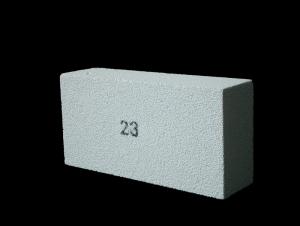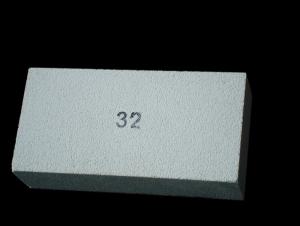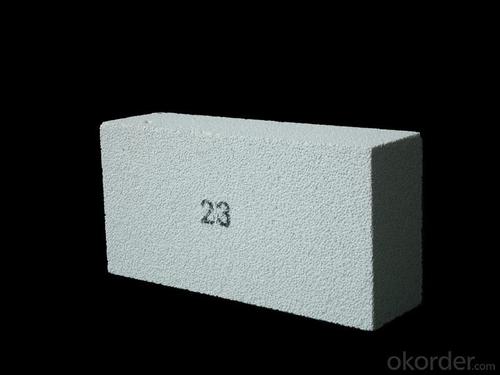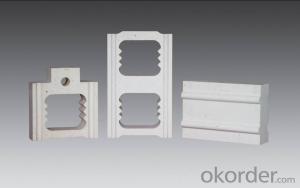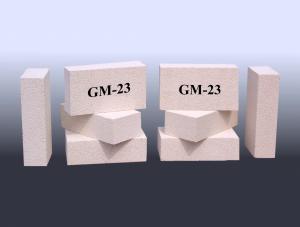Insulating Fire Brick - MS32
- Loading Port:
- China Main Port
- Payment Terms:
- TT or L/C
- Min Order Qty:
- 1000 pcs pc
- Supply Capability:
- 1000 Tons Per Month pc/month
OKorder Service Pledge
OKorder Financial Service
You Might Also Like
General Information of Insulating Fire Bricks MS32
Insulating fire brick MS32 temperature is 1760℃(3200℉). We could supply a wide range of shapes. For insulating fire bricks MS32,we choose the extruding method. Extruding insulating fire bricks have better strength and offering great performance in load bearing applications and in conditions where abrasion from mechanical abuse or flow of hot gases.
Feature of Insulating Fire Bricks MS32
Light weight and low thermal conductivity
Low heat storage
Low iron and impurities
High thermal shock resistance
Application of Insulating Fire Bricks MS32
The insulating firebricks can be used as a hot face lining directly exposed to the heat or as a backup insulation layer in iron and steel mills, non-ferrous foundries, petrochemical, ceramic, glass.
Data Sheet of Insulating Fire Bricks MS32
|
| GJM32 |
Physical Properties: |
|
|
Classifiction Temperature | ℃ | 1650 |
Density | Kg/m3 | 1100 |
Cold Crushing Strength | Mpa | 3.5 |
Reheating Linear Change(24hrs) |
|
|
1650℃ | % | 0.8 |
Hot Load Strength Deform(90 minutes) |
|
|
1370℃ at 0.069 Mpa(10psi) | % | 0.1 |
Thermal Conductivity |
|
|
400℃ | W/m.k | 0.32 |
600℃ | W/m.k | 0.35 |
800℃ | W/m.k | 0.38 |
1000℃ | W/m.k | 0.42 |
1200℃ | W/m.k | 0.44 |
Specific Heat | KJ/Kg.K | 1.10 |
Chemical Analysis: |
|
|
Al2O3 | % | 75.0 |
SiO2 | % | 23.2 |
Fe2O3 | % | 0.5 |
TiO2 | % | 0.1 |
CaO | % | 0.1 |
MgO | % | 0.1 |
Na2O+K2O | % | 0.6 |
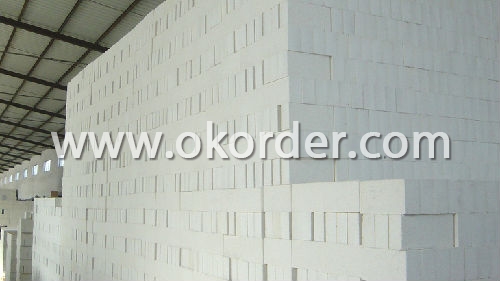
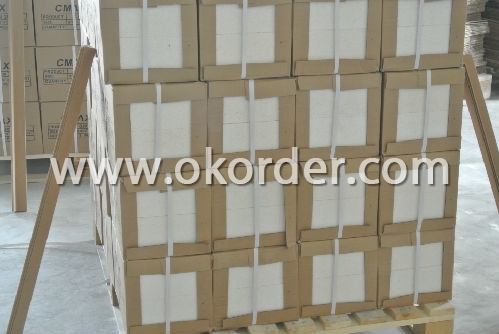
- Q: Can insulating fire bricks be used in the construction of smelter crucibles?
- Insulating fire bricks are indeed suitable for constructing smelter crucibles. These bricks are composed of high-temperature-resistant materials, which make them ideal for smelting tasks. Their low thermal conductivity aids in preserving heat and preventing excessive heat loss from the crucible. Consequently, insulating fire bricks are perfect for creating a well-insulated and efficient crucible that can endure the intense heat and thermal shock involved in smelting processes. Furthermore, these bricks are lightweight and easily malleable, enabling convenient construction and customization of the crucible's design. Ultimately, incorporating insulating fire bricks in smelter crucible construction enhances thermal efficiency and durability, resulting in more effective and productive smelting operations.
- Q: Are insulating fire bricks resistant to moisture or water damage?
- Insulating fire bricks are generally resistant to moisture or water damage. These bricks are designed to have low porosity and high density, which helps prevent water absorption. Additionally, they are typically made from materials like alumina or silica, which have inherent resistance to moisture. However, it is important to note that no material is completely impervious to water, and prolonged exposure to moisture or water can still have some effect on the insulating fire bricks over time. Therefore, it is recommended to take necessary precautions, such as applying appropriate sealants or coatings, to enhance their resistance to moisture or water damage in certain applications.
- Q: Can insulating fire bricks be used in cryogenic applications?
- Insulating fire bricks, also known as refractory bricks, are primarily designed for high-temperature applications and are commonly used in furnaces and kilns. However, when it comes to cryogenic applications, where extremely low temperatures are involved, insulating fire bricks may not be the most suitable choice. Cryogenic temperatures, typically below -150 degrees Celsius (-238 degrees Fahrenheit), pose unique challenges for materials due to the severe thermal stresses they experience. Insulating fire bricks are typically composed of materials such as alumina and silica, which have limited thermal shock resistance and can become brittle at very low temperatures. This brittleness can lead to cracking and failure when exposed to cryogenic conditions. Additionally, insulating fire bricks have relatively high thermal conductivity, which means they can conduct heat relatively well. In cryogenic applications, where minimizing heat transfer is crucial, materials with lower thermal conductivity are preferred. Therefore, insulating fire bricks, with their higher thermal conductivity, may not be the most efficient choice for cryogenic applications. Instead, materials with excellent thermal insulation properties and low thermal conductivity, such as aerogels or foams made from materials like silica or carbon, are often preferred for cryogenic applications. These materials offer superior thermal insulation and better resistance to extreme temperatures, ensuring the efficient and reliable performance required in cryogenic environments. In summary, while insulating fire bricks are suitable for high-temperature applications, they may not be the best choice for cryogenic applications due to their brittleness at low temperatures and relatively high thermal conductivity. Materials specifically designed for cryogenic conditions, such as aerogels or foams, are more suitable for these extreme temperature environments.
- Q: Are insulating fire bricks resistant to high-velocity gas flow erosion?
- Yes, insulating fire bricks are generally resistant to high-velocity gas flow erosion. These bricks are designed to withstand high temperatures and are made from materials that can withstand the erosive effects of gases flowing at high velocities. However, the resistance may vary depending on the specific composition and quality of the fire bricks.
- Q: Are insulating fire bricks resistant to carbon dioxide?
- Yes, insulating fire bricks are resistant to carbon dioxide.
- Q: How do insulating fire bricks affect the overall insulation properties of a structure?
- Insulating fire bricks greatly enhance the insulation properties of a structure due to their low thermal conductivity. These bricks effectively minimize heat transfer and prevent the escape of heat, resulting in improved energy efficiency and reduced heating costs. Additionally, their high resistance to heat and excellent thermal stability contribute to maintaining a consistent and comfortable indoor temperature.
- Q: Can insulating fire bricks be cut or shaped using common tools?
- Yes, insulating fire bricks can be cut or shaped using common tools. These bricks are generally made from lightweight refractory materials such as clay and minerals, which make them easier to cut and shape compared to traditional fire bricks. Common tools like a handsaw, angle grinder, or even a chisel and hammer can be used to cut and shape the bricks according to the desired size and design. However, it is important to wear protective gear such as gloves, goggles, and a dust mask while working with insulating fire bricks to avoid any potential health hazards.
- Q: Can insulating fire bricks be used for insulation in industrial chimneys?
- Yes, insulating fire bricks can be used for insulation in industrial chimneys. Insulating fire bricks are specifically designed to withstand high temperatures and provide excellent insulation properties. They are made from lightweight refractory materials that have low thermal conductivity, allowing them to effectively retain heat and prevent its transfer to the surroundings. This makes them ideal for use in industrial chimneys, where insulation is crucial to minimize heat loss and improve energy efficiency. Additionally, insulating fire bricks are also resistant to chemical corrosion, making them suitable for the harsh and corrosive environments typically found in industrial chimneys.
- Q: Is it possible to repair damaged insulating fire bricks?
- Repairing damaged insulating fire bricks is indeed possible, and the method required will depend on the extent and type of damage. For minor cracks or chips, one can utilize a refractory mortar that is specifically designed to endure high temperatures and create a strong bond. This mortar can effectively fill in the gaps and restore the brick's integrity. However, if a larger section of the brick is damaged or completely missing, it may be necessary to replace the entire brick. In such a scenario, the damaged brick must be cautiously removed, and a new one can be installed with the appropriate refractory mortar. It is crucial to ensure that the repaired or replaced brick adheres to the original specifications and quality to guarantee proper insulation and structural integrity. It is highly recommended to seek advice from a professional or carefully follow the manufacturer's guidelines for the specific repair process.
- Q: Can insulating fire bricks be used in refractory fibers?
- Insulating fire bricks are not suitable for use in refractory fibers. These bricks are solid and made from refractory materials, serving to insulate and retain heat in high-temperature scenarios. Conversely, refractory fibers are lightweight and flexible materials composed of ceramic or mineral fibers. They are employed for insulation and lining in a range of industrial applications, such as furnaces, kilns, and boilers. Due to their distinct properties and structures, these two materials are incompatible. Consequently, it is advisable to refrain from using insulating fire bricks in conjunction with refractory fibers.
1. Manufacturer Overview
| Location | Shandong, China |
| Year Established | 2007 |
| Annual Output Value | Above US$ 5 Million |
| Main Markets | 10.00% Northern Europe 30.00% North America 30.00% Eastern Asia 5.00% Africa 10.00% Southeast Asia 15.00% Western Europe |
| Company Certifications | ISO 9001:2008 |
2. Manufacturer Certificates
| a) Certification Name | |
| Range | |
| Reference | |
| Validity Period |
3. Manufacturer Capability
| a) Trade Capacity | |
| Nearest Port | Qingdao Port |
| Export Percentage | 90% |
| No.of Employees in Trade Department | 10 |
| Language Spoken: | English; Chinese |
| b) Factory Information | |
| Factory Size: | Above 16,000 square meters |
| No. of Production Lines | Above 3 |
| Contract Manufacturing | OEM Service Offered; Design Service Offered |
| Product Price Range | High; Average |
Send your message to us
Insulating Fire Brick - MS32
- Loading Port:
- China Main Port
- Payment Terms:
- TT or L/C
- Min Order Qty:
- 1000 pcs pc
- Supply Capability:
- 1000 Tons Per Month pc/month
OKorder Service Pledge
OKorder Financial Service
Similar products
Hot products
Hot Searches
Related keywords
